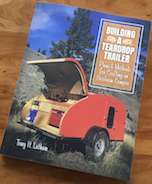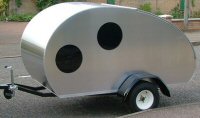Sandwich Skeleton Questions aka Getting Meat Off the Bones.
25 posts
• Page 1 of 2 • 1, 2
Sandwich Skeleton Questions aka Getting Meat Off the Bones.
So I'm starting the planning phase of my teardrop. I'm hoping to have it constructed for a late August early September trip. My current tow vehicle is a Nissan Altima. So weight is a concern.
I'm currently working on converting the Generic Benroy Plan into Solidworks. Long story short I'm a Controls Engineer at my place of employment and they have a need for me to understand at least basic Solidworks. So as a learning exercise they are allowing me a few hours a week to work on this on company time. Yea me.
I work for a machine builder and we have lots of fancy tools like CNCs and Waterjets. My friend happens to be the boss of those machines so I get access. I tell you all this to explain where I am.
I think I need the loaded weight of the trailer under 1,000lbs. I looked at foamies and love the idea but want the classic look of aluminum. So I'm trying to build as light as I can using sandwich walls. The decision was made based off of a desire to go light so no full plywood walls. And wanting aluminum exterior so no foamies. Plus the advantages I have of having a waterjet and cnc to use means I can build the skeleton quicker than most could do a frame.
I'm thinking .04 aluminum for the exterior skin and 1/8" luan for the interior. I think 3/4" plywood for the cabinets and skeleton. I could be talked down if people think I could go skinnier. My plan for the skeleton is to leave 3/4" of material around the entire outside and the door area then leave the same where my cabinets are. Is 3/4" enough? Can I go thinner? I plan on rounding the inside corners of my cutouts to a .5" fillet. If I downsize the cabinets to 1/2" plywood then my plan is to downsize the ribs as well while leaving the outside 3/4". Would that be ok? I will fill the cutouts with foam board. I do need to route some wiring but my hopes are to run the wires through the ceiling area and drop into a raceway between my galley and my inside cupboards.
I also will need to run some stabalizing ribs to the door frame area because obviously it can't float in space. The cabinets I'm not sure I need to run support ribs. If I do it might be stronger but my understaing is most of us are making the skeleton stronger than needed. If I don't then well less weight. I guess I need some amount of area for glue to hold the skins in place so maybe I'll need to run a few ribs for that?
Am I headed down a decent path? Any feed back? Thanks!
I'm currently working on converting the Generic Benroy Plan into Solidworks. Long story short I'm a Controls Engineer at my place of employment and they have a need for me to understand at least basic Solidworks. So as a learning exercise they are allowing me a few hours a week to work on this on company time. Yea me.
I work for a machine builder and we have lots of fancy tools like CNCs and Waterjets. My friend happens to be the boss of those machines so I get access. I tell you all this to explain where I am.
I think I need the loaded weight of the trailer under 1,000lbs. I looked at foamies and love the idea but want the classic look of aluminum. So I'm trying to build as light as I can using sandwich walls. The decision was made based off of a desire to go light so no full plywood walls. And wanting aluminum exterior so no foamies. Plus the advantages I have of having a waterjet and cnc to use means I can build the skeleton quicker than most could do a frame.
I'm thinking .04 aluminum for the exterior skin and 1/8" luan for the interior. I think 3/4" plywood for the cabinets and skeleton. I could be talked down if people think I could go skinnier. My plan for the skeleton is to leave 3/4" of material around the entire outside and the door area then leave the same where my cabinets are. Is 3/4" enough? Can I go thinner? I plan on rounding the inside corners of my cutouts to a .5" fillet. If I downsize the cabinets to 1/2" plywood then my plan is to downsize the ribs as well while leaving the outside 3/4". Would that be ok? I will fill the cutouts with foam board. I do need to route some wiring but my hopes are to run the wires through the ceiling area and drop into a raceway between my galley and my inside cupboards.
I also will need to run some stabalizing ribs to the door frame area because obviously it can't float in space. The cabinets I'm not sure I need to run support ribs. If I do it might be stronger but my understaing is most of us are making the skeleton stronger than needed. If I don't then well less weight. I guess I need some amount of area for glue to hold the skins in place so maybe I'll need to run a few ribs for that?
Am I headed down a decent path? Any feed back? Thanks!
- eodmike
- Teardrop Inspector
- Posts: 11
- Joined: Tue Feb 27, 2018 5:35 pm
Re: Sandwich Skeleton Questions aka Getting Meat Off the Bon
I suspect anyone that's built a sandwiched wall has had the same thoughts.
Here's the last skeleton I built and I think it's a bit overdone but not much. (It's 10' long joined by a spline joint just forward of the door opening. The joint relies on the plywood sheathing for strength and thus the extra wood for a glueing surface.) And there's extra wood in the galley since it'll be sheathed with 8' long 1/4' plywood that's butt joined back there.
The rear of the skeleton edge is 4" since I use Fredrick's method that utilizes the outside of the wall as the sides of the hatch. (Is this getting confusing?)

Plan A on for that 'drop was to attach the fenders to the walls –-thus the hardpoints. In the end, I deferred to attach them to the chassis. This teardrop was built to boondock and I just don't think wall-mounted fenders are a good idea in the sticks. A damaged fender may mean a damaged wall.
You'll also note a horizontal piece above the fender points. The galley counter protrudes inside the cabin to form the lower shelf and thus it needed hard points on the wall. The stub just above it is for the upper shelf. And that little chunk above it is a hard point for a hook to hang clothes. So anywhere you are going to attach something you'll need a hard point.
"I think 3/4" plywood for the cabinets and skeleton." I built a little 4x8 and used 1/2" ply for the skeleton. Attaching the ceiling on that narrow lip was a challenge but it worked. It's my opinion after that build that it is better to stick with a 3/4" skeleton but skinny it down.
Here's the ledge on that little drop:

"My plan for the skeleton is to leave 3/4" of material around the entire outside and the door area then leave the same where my cabinets are. Is 3/4" enough?" It depends on the location. Assuming you are going to build a ledge to attach your ceiling and spars, I would feel more comfortable with at least 1 & 1/2" to avoid splitting. And again I'd want more meat to attach the wall to the floor. I join my walls to the floor using pocket holes on the side, screws from the bottom, and of course glue.

"...but my understaing is most of us are making the skeleton stronger than needed..."
I'm sure we do. But cutting a skeleton edge from (let's say) 2" down to 3/4" isn't saving much weight. (Think for a moment what that piece would weigh.)
If you want to reduce weight, take a hard look at the steel in your chassis.

Tony
Epilogue: Take another look at that skeleton of mine. Mentally remove an inch or so of wood around it and then weigh that piece in your mind.
Here's the last skeleton I built and I think it's a bit overdone but not much. (It's 10' long joined by a spline joint just forward of the door opening. The joint relies on the plywood sheathing for strength and thus the extra wood for a glueing surface.) And there's extra wood in the galley since it'll be sheathed with 8' long 1/4' plywood that's butt joined back there.
The rear of the skeleton edge is 4" since I use Fredrick's method that utilizes the outside of the wall as the sides of the hatch. (Is this getting confusing?)

Plan A on for that 'drop was to attach the fenders to the walls –-thus the hardpoints. In the end, I deferred to attach them to the chassis. This teardrop was built to boondock and I just don't think wall-mounted fenders are a good idea in the sticks. A damaged fender may mean a damaged wall.
You'll also note a horizontal piece above the fender points. The galley counter protrudes inside the cabin to form the lower shelf and thus it needed hard points on the wall. The stub just above it is for the upper shelf. And that little chunk above it is a hard point for a hook to hang clothes. So anywhere you are going to attach something you'll need a hard point.
"I think 3/4" plywood for the cabinets and skeleton." I built a little 4x8 and used 1/2" ply for the skeleton. Attaching the ceiling on that narrow lip was a challenge but it worked. It's my opinion after that build that it is better to stick with a 3/4" skeleton but skinny it down.
Here's the ledge on that little drop:

"My plan for the skeleton is to leave 3/4" of material around the entire outside and the door area then leave the same where my cabinets are. Is 3/4" enough?" It depends on the location. Assuming you are going to build a ledge to attach your ceiling and spars, I would feel more comfortable with at least 1 & 1/2" to avoid splitting. And again I'd want more meat to attach the wall to the floor. I join my walls to the floor using pocket holes on the side, screws from the bottom, and of course glue.

"...but my understaing is most of us are making the skeleton stronger than needed..."
I'm sure we do. But cutting a skeleton edge from (let's say) 2" down to 3/4" isn't saving much weight. (Think for a moment what that piece would weigh.)
If you want to reduce weight, take a hard look at the steel in your chassis.

Tony

Epilogue: Take another look at that skeleton of mine. Mentally remove an inch or so of wood around it and then weigh that piece in your mind.

-

tony.latham - Gold Donating Member
- Posts: 7073
- Images: 17
- Joined: Mon Jul 08, 2013 4:03 pm
- Location: Middle of Idaho on the edge of nowhere




